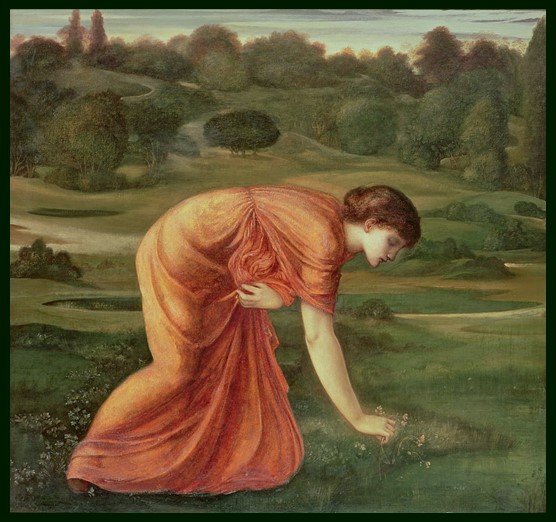
The March Marigold, circa the 1870s, Oil and Mixed Media on Canvas, 71.7×77.4 cm, Private Collection https://www.wikiart.org/en/edward-burne-jones/the-march-marigold
The March Marigold by Sir Edward Coley Burne-Jones celebrates the vibrantly tinted and warmly hued, Μarigold, the flower that carries rich symbolic meaning across various cultures. Often associated with the sun, these flowers symbolize positivity, joy, and the life-giving energy of sunlight. In many traditions, marigolds are also linked to themes of celebration, prosperity, and good fortune, making them popular choices for festivals, weddings, and other auspicious occasions. Additionally, marigolds are known for their resilience and ability to thrive in diverse conditions, serving as a symbol of endurance and tenacity. Whether used in religious ceremonies, cultural celebrations, or simply as decorative elements, marigolds convey a profound message of optimism, resilience, and the enduring beauty that can emerge from even challenging circumstances.
So… What Do Marigolds Symbolize Internationally?
The scientific name of the Marigold flower is Calendula officinalis, and it comes from Latin. The Romans noticed the plant’s consistent flowering on the Calends, the first days of each month in the Roman Calendar and associated it with the regular intervals of their calendar, hence the name Calendula. The specific epithet officinalis, Latin as well, indicates that the plant was officially used as a medicinal or culinary herb, emphasizing its recognized and established role in traditional practices.
In ancient Greece and Rome, the bright and vibrant marigold flowers were seen as a reflection of the sun’s rays, and they were sometimes considered symbols of light and positivity, often linked to the God Apollo, and Goddesses Aphrodite or Hera. They were also valued for their medicinal properties. Calendula flowers, used for their healing attributes, were employed in salves and ointments to treat wounds, inflammation, and various skin conditions. Additionally, Calendula petals were incorporated into culinary practices, lending color to salads and dishes. The plant’s association with health and well-being is reflected in its use in rituals and ceremonies, demonstrating its cultural and practical importance in ancient Greek and Roman society.

Stooping Woman, circa the 1870s, Chalk on paper, 152 × 165 mm, TATE, London, UK https://www.tate.org.uk/art/artworks/burne-jones-stooping-woman-a00069
In Europe, during the Middle Ages, the golden color of the Marigolds, reminiscent of the radiance associated with Mary’s purity and divine nature in the Christian tradition, was linked to the Virgin Mary and her pure heart. Over time, this visual connection, coupled with the flowers’ frequent use in religious ceremonies and art, solidified the link between marigolds and the Virgin Mary in Christian symbolism. While marigolds are not explicitly mentioned in the Bible, their use in religious and cultural practices reflects a rich tapestry of symbolic meanings within the Christian context.
In Mexico, Marigolds, or Cempasúchil in Spanish, hold deep cultural significance, particularly during the Dia de los Muertos (Day of the Dead) celebration. Marigolds are thought to guide the spirits of the deceased back to the world of the living with their vibrant orange and yellow colors. Families often create intricate floral arrangements and altars adorned with marigolds, candles, and mementos to honor and remember loved ones who have passed away. The flower’s strong aroma is believed to attract the spirits, and its use in Day of the Dead rituals reflects a blend of indigenous traditions with Catholicism, symbolizing the interconnectedness of life and death in Mexican culture. Marigold’s role in these traditions goes beyond aesthetics, embodying a powerful symbol of remembrance, spirituality, and the enduring connection between the living and the deceased.
In India, Marigolds hold multifaceted cultural and religious significance. These vibrant flowers, known as Genda Phool in Hindi, are commonly used in religious ceremonies, festivals, and decorations. Marigold garlands are often offered in temples to various deities, symbolizing purity and auspiciousness. The golden hue of Marigolds is associated with the sun, representing positive energy and prosperity. Additionally, during festivals like Diwali and Durga Puja, Marigolds are extensively used for decoration, adorning homes, and public spaces as a symbol of joy and celebration. The flower’s resilience and vibrant color contribute to its popularity in Indian culture, where marigolds serve as more than mere ornamental elements, embodying spiritual, cultural, and festive significance.
For a Student Activity inspired by the Marigold Flower, please… Check HERE!